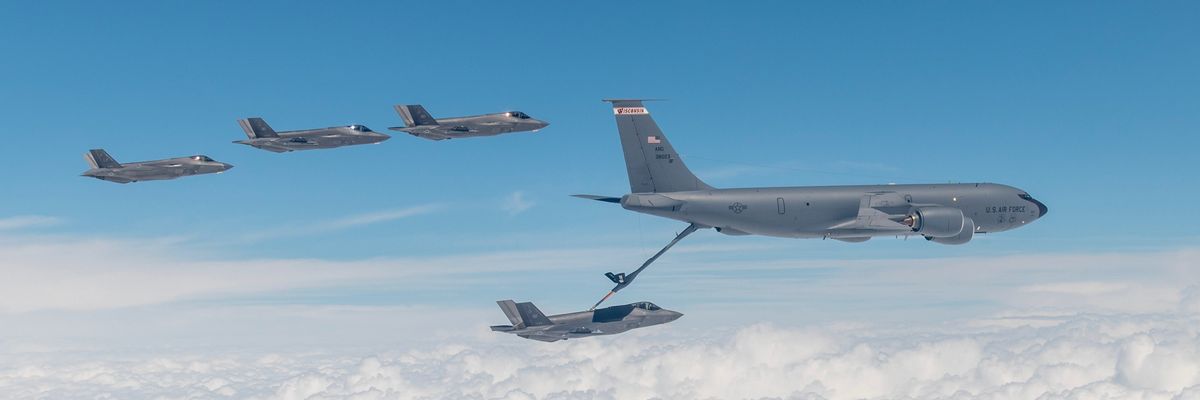
Around $400 million worth of U.S. warplanes—including F-35 Lightning fighters, one of which is seen docked to a KC-135 for refueling—are seen flying in this April 26, 2023 photo.
Here's How Much You Gave Last Year to The Pentagon (Hint: It Was a Lot)
Your tax dollars enriched Pentagon contractors at the expense of better healthcare, education, clean air and water, disaster management, and more.
Ever wonder where your taxes go? Each year, the Institute for Policy Studies releases a tax receipt so you can find out.
One item always stands out: the Pentagon—and the contractors who profit off it.
In 2023, the average taxpayer spent $2,974 on the Pentagon. Of that, just $705 went to salaries for the troops, who often have to rely on programs like food stamps. A much larger sum—$1,748—went to corporate Pentagon contractors. That’s more than the average American’s monthly rent, $1,372.
Maybe we should spend more on regulating companies like Boeing than subsidizing them?
From Lockheed Martin (the top federal contractor and longtime weapons maker) to SpaceX (which Elon Musk runs when he’s not spewing racist and antisemitic tropes), these corporations don’t need your support. And they aren’t operating with your well-being in mind.
Enriching them comes at the cost of better healthcare, education, clean air and water, disaster management, and more. Here are just five examples from the average tax bill.
1. Pentagon contractors ($1,759) vs. the Child Tax Credit ($110).
In 2024, the Pentagon budget is set to increase by $27 billion, bringing the department’s budget to about $825 billion. About half of that will go to for-profit contractors.
Meanwhile, an expansion of the Child Tax Credit during the pandemic succeeded in cutting the child poverty rate almost in half—progress that was almost immediately reversed when the expansion expired in late 2021.
Lifting kids out of poverty can have lifelong effects on their health, education, and employment. Isn’t that worth more than a tiny fraction of our spending on military contracts?
2. Lockheed Martin ($249) vs. renewable energy ($11).
Lockheed Martin is perhaps best-known as the maker of the always over-budget, never-quite-ready F-35 jet fighter, which has spontaneously caught fire three separate times. Despite claims that programs like this are job creators, Lockheed recently made moves to cut jobs.
Meanwhile, despite the necessity of addressing climate change and reducing our reliance on fossil fuels, the average taxpayer’s contribution to renewable energy programs tops out at just $11.
3. Boeing ($87) vs. the Federal Aviation Administration ($23).
From commercial flights that crashed to others that fell apart in midair, Boeing’s commercial safety record lately has been abysmal. Yet the company is also among the top five Pentagon contractors. Among other military aircraft, it’s the maker of the V-22 Osprey that crashed and killed eight service members in November.
The FAA, of course, is the understaffed, underfunded government regulator responsible for the safety of commercial flights. Maybe we should spend more on regulating companies like Boeing than subsidizing them?
4. Federal prisons ($32.29) vs. substance use and mental health programs ($31.69).
With about 2 million people incarcerated nationally, about one in three Americans will have an immediate family member who has been in prison or jail. Your federal income tax dollars support this system, which often treats substance use and mental health challenges as issues best confined to a prison cell.
By contrast, help for substance use disorder or mental health issues can still be profoundly hard to get, as any affected person or family member will tell you. What if we spent more on treating these health conditions than punishing them?
5. Foreign militaries ($112) vs. wildfire management ($14).
From Afghanistan and Iraq to Ukraine and now Gaza, it feels like the U.S. is always either starting a war, fighting a war, or subsidizing a war. These wars are increasingly unpopular—and they’re not making us any safer.
Meanwhile, a growing number of Americans have experienced the direct or indirect effects of wildfire in recent years. These disasters cost upward of $394 billion each year. Isn’t that threat worth addressing?
Pentagon contractors want us to think we need what they’re selling, but wrong-headed priorities like these mean we’re actually worse off. Spread the word: Every taxpayer deserves better
An Urgent Message From Our Co-Founder
Dear Common Dreams reader, The U.S. is on a fast track to authoritarianism like nothing I've ever seen. Meanwhile, corporate news outlets are utterly capitulating to Trump, twisting their coverage to avoid drawing his ire while lining up to stuff cash in his pockets. That's why I believe that Common Dreams is doing the best and most consequential reporting that we've ever done. Our small but mighty team is a progressive reporting powerhouse, covering the news every day that the corporate media never will. Our mission has always been simple: To inform. To inspire. And to ignite change for the common good. Now here's the key piece that I want all our readers to understand: None of this would be possible without your financial support. That's not just some fundraising cliche. It's the absolute and literal truth. We don't accept corporate advertising and never will. We don't have a paywall because we don't think people should be blocked from critical news based on their ability to pay. Everything we do is funded by the donations of readers like you. Will you donate now to help power the nonprofit, independent reporting of Common Dreams? Thank you for being a vital member of our community. Together, we can keep independent journalism alive when it’s needed most. - Craig Brown, Co-founder |
Ever wonder where your taxes go? Each year, the Institute for Policy Studies releases a tax receipt so you can find out.
One item always stands out: the Pentagon—and the contractors who profit off it.
In 2023, the average taxpayer spent $2,974 on the Pentagon. Of that, just $705 went to salaries for the troops, who often have to rely on programs like food stamps. A much larger sum—$1,748—went to corporate Pentagon contractors. That’s more than the average American’s monthly rent, $1,372.
Maybe we should spend more on regulating companies like Boeing than subsidizing them?
From Lockheed Martin (the top federal contractor and longtime weapons maker) to SpaceX (which Elon Musk runs when he’s not spewing racist and antisemitic tropes), these corporations don’t need your support. And they aren’t operating with your well-being in mind.
Enriching them comes at the cost of better healthcare, education, clean air and water, disaster management, and more. Here are just five examples from the average tax bill.
1. Pentagon contractors ($1,759) vs. the Child Tax Credit ($110).
In 2024, the Pentagon budget is set to increase by $27 billion, bringing the department’s budget to about $825 billion. About half of that will go to for-profit contractors.
Meanwhile, an expansion of the Child Tax Credit during the pandemic succeeded in cutting the child poverty rate almost in half—progress that was almost immediately reversed when the expansion expired in late 2021.
Lifting kids out of poverty can have lifelong effects on their health, education, and employment. Isn’t that worth more than a tiny fraction of our spending on military contracts?
2. Lockheed Martin ($249) vs. renewable energy ($11).
Lockheed Martin is perhaps best-known as the maker of the always over-budget, never-quite-ready F-35 jet fighter, which has spontaneously caught fire three separate times. Despite claims that programs like this are job creators, Lockheed recently made moves to cut jobs.
Meanwhile, despite the necessity of addressing climate change and reducing our reliance on fossil fuels, the average taxpayer’s contribution to renewable energy programs tops out at just $11.
3. Boeing ($87) vs. the Federal Aviation Administration ($23).
From commercial flights that crashed to others that fell apart in midair, Boeing’s commercial safety record lately has been abysmal. Yet the company is also among the top five Pentagon contractors. Among other military aircraft, it’s the maker of the V-22 Osprey that crashed and killed eight service members in November.
The FAA, of course, is the understaffed, underfunded government regulator responsible for the safety of commercial flights. Maybe we should spend more on regulating companies like Boeing than subsidizing them?
4. Federal prisons ($32.29) vs. substance use and mental health programs ($31.69).
With about 2 million people incarcerated nationally, about one in three Americans will have an immediate family member who has been in prison or jail. Your federal income tax dollars support this system, which often treats substance use and mental health challenges as issues best confined to a prison cell.
By contrast, help for substance use disorder or mental health issues can still be profoundly hard to get, as any affected person or family member will tell you. What if we spent more on treating these health conditions than punishing them?
5. Foreign militaries ($112) vs. wildfire management ($14).
From Afghanistan and Iraq to Ukraine and now Gaza, it feels like the U.S. is always either starting a war, fighting a war, or subsidizing a war. These wars are increasingly unpopular—and they’re not making us any safer.
Meanwhile, a growing number of Americans have experienced the direct or indirect effects of wildfire in recent years. These disasters cost upward of $394 billion each year. Isn’t that threat worth addressing?
Pentagon contractors want us to think we need what they’re selling, but wrong-headed priorities like these mean we’re actually worse off. Spread the word: Every taxpayer deserves better
- 12 House Dems Join GOP to Approve Tax Gift to Rich Alongside Israel Aid for Gaza Slaughter ›
- Report Details How Rich CEOs Avoid Taxes on Retirement Funds as Their Employees Struggle ›
- High Flyers 2023: How Ultra-Rich Private Jet Travel Costs the Rest of Us and Burns Up Our Planet ›
- Tlaib Says $900 Billion Military Budget ‘Impossible to Justify’ ›
- In Latest Crackdown on Rich Tax Cheats, IRS Pursues 125,000 Non-Filing Cases ›
- Paying Rate of Just 6%, Amazon Avoided More Than $5 Billion in Taxes Last Year ›
Ever wonder where your taxes go? Each year, the Institute for Policy Studies releases a tax receipt so you can find out.
One item always stands out: the Pentagon—and the contractors who profit off it.
In 2023, the average taxpayer spent $2,974 on the Pentagon. Of that, just $705 went to salaries for the troops, who often have to rely on programs like food stamps. A much larger sum—$1,748—went to corporate Pentagon contractors. That’s more than the average American’s monthly rent, $1,372.
Maybe we should spend more on regulating companies like Boeing than subsidizing them?
From Lockheed Martin (the top federal contractor and longtime weapons maker) to SpaceX (which Elon Musk runs when he’s not spewing racist and antisemitic tropes), these corporations don’t need your support. And they aren’t operating with your well-being in mind.
Enriching them comes at the cost of better healthcare, education, clean air and water, disaster management, and more. Here are just five examples from the average tax bill.
1. Pentagon contractors ($1,759) vs. the Child Tax Credit ($110).
In 2024, the Pentagon budget is set to increase by $27 billion, bringing the department’s budget to about $825 billion. About half of that will go to for-profit contractors.
Meanwhile, an expansion of the Child Tax Credit during the pandemic succeeded in cutting the child poverty rate almost in half—progress that was almost immediately reversed when the expansion expired in late 2021.
Lifting kids out of poverty can have lifelong effects on their health, education, and employment. Isn’t that worth more than a tiny fraction of our spending on military contracts?
2. Lockheed Martin ($249) vs. renewable energy ($11).
Lockheed Martin is perhaps best-known as the maker of the always over-budget, never-quite-ready F-35 jet fighter, which has spontaneously caught fire three separate times. Despite claims that programs like this are job creators, Lockheed recently made moves to cut jobs.
Meanwhile, despite the necessity of addressing climate change and reducing our reliance on fossil fuels, the average taxpayer’s contribution to renewable energy programs tops out at just $11.
3. Boeing ($87) vs. the Federal Aviation Administration ($23).
From commercial flights that crashed to others that fell apart in midair, Boeing’s commercial safety record lately has been abysmal. Yet the company is also among the top five Pentagon contractors. Among other military aircraft, it’s the maker of the V-22 Osprey that crashed and killed eight service members in November.
The FAA, of course, is the understaffed, underfunded government regulator responsible for the safety of commercial flights. Maybe we should spend more on regulating companies like Boeing than subsidizing them?
4. Federal prisons ($32.29) vs. substance use and mental health programs ($31.69).
With about 2 million people incarcerated nationally, about one in three Americans will have an immediate family member who has been in prison or jail. Your federal income tax dollars support this system, which often treats substance use and mental health challenges as issues best confined to a prison cell.
By contrast, help for substance use disorder or mental health issues can still be profoundly hard to get, as any affected person or family member will tell you. What if we spent more on treating these health conditions than punishing them?
5. Foreign militaries ($112) vs. wildfire management ($14).
From Afghanistan and Iraq to Ukraine and now Gaza, it feels like the U.S. is always either starting a war, fighting a war, or subsidizing a war. These wars are increasingly unpopular—and they’re not making us any safer.
Meanwhile, a growing number of Americans have experienced the direct or indirect effects of wildfire in recent years. These disasters cost upward of $394 billion each year. Isn’t that threat worth addressing?
Pentagon contractors want us to think we need what they’re selling, but wrong-headed priorities like these mean we’re actually worse off. Spread the word: Every taxpayer deserves better
- 12 House Dems Join GOP to Approve Tax Gift to Rich Alongside Israel Aid for Gaza Slaughter ›
- Report Details How Rich CEOs Avoid Taxes on Retirement Funds as Their Employees Struggle ›
- High Flyers 2023: How Ultra-Rich Private Jet Travel Costs the Rest of Us and Burns Up Our Planet ›
- Tlaib Says $900 Billion Military Budget ‘Impossible to Justify’ ›
- In Latest Crackdown on Rich Tax Cheats, IRS Pursues 125,000 Non-Filing Cases ›
- Paying Rate of Just 6%, Amazon Avoided More Than $5 Billion in Taxes Last Year ›

